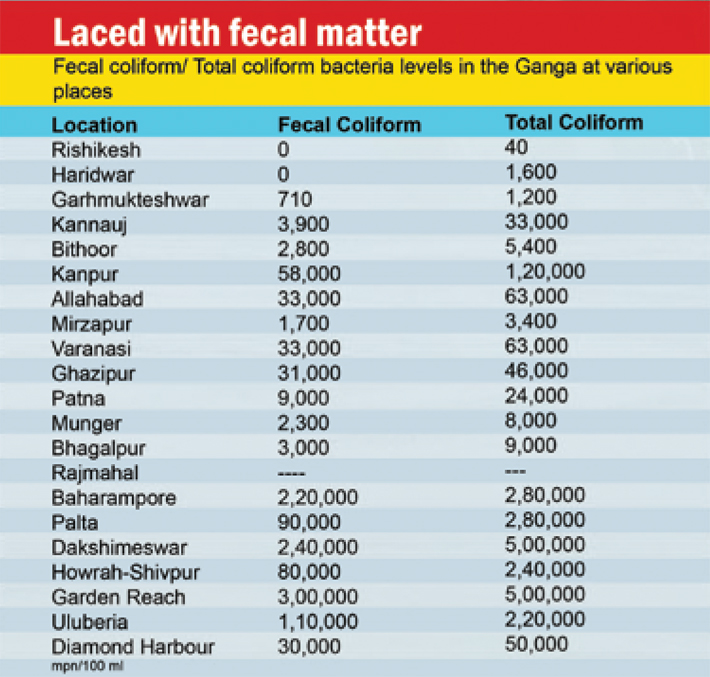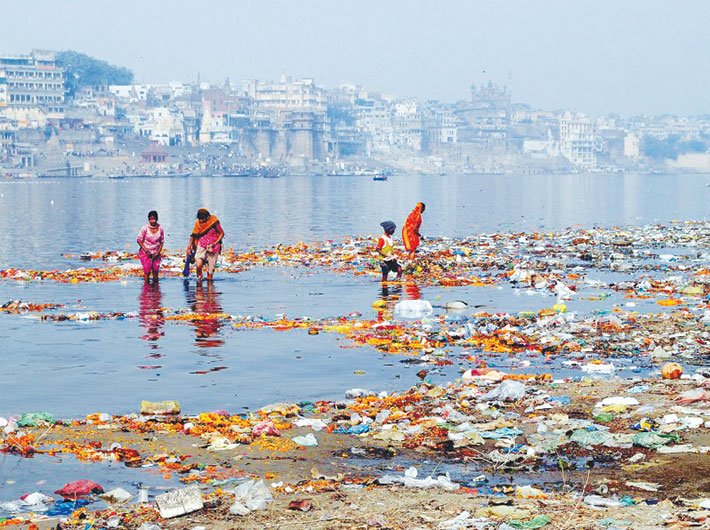Its holy water is loaded with fecal bacteria, a reply to an RTI application from Governance Now reveals
Everyone knows that the Ganga is heavily polluted. Along the 2,525 km of the river, there are just 57 monitoring stations to assess water quality. Few as they are, they tell a horrific story if one only goes by the amount of fecal matter in the water that is considered holy. Sewage treatment plants, too, have a direct bearing on keeping the Ganga clean: because there are many more towns and cities along the Ganga, there ought to be more sewage treatment plants along the Ganga, but right now there are just 16. There are plans to have 41 more, which are at various stages of bidding/construction.
In reply to an RTI application from Governance Now, the Central Pollution Control Board revealed that Ganga water is contaminated in places with up to 3 lakh fecal coliform bacteria and 5 lakh total coliform bacteria per 100 ml. The values are given in mpn/100 ml, or most probable number per 100 ml, a statistical way of assessing one aspect of water quality, that is, how much human waste it contains.
River water is considered fit for bathing if faecal coliform bacteria count is between 500 mpn per 100 ml (the desirable limit) and 2,500 mpn per 100 ml (the maximum permissible limit). Excessive presence of high concentrations of bacteria is directly related to the release of untreated sewage into the river water. Consumption of water contaminated beyond permissible limits can cause a host of diseases, from gastroenteritis to virulent forms of hepatitis.
The river water has zero coliform bacteria from Gangotri onwards – till it arrives in Rishikesh, where the count goes up to 40 mpn/100 ml. Then, riverside town by riverside town, city by city, the values shoot up. In Kanpur, the fecal coliform count is 58,000 mpn/100 ml and the total coliform count 1.2 lakh mpn/100 ml. The data for fecal coliform and total coliform for Sangam, Allahabad, matches that of Malaviya Bridge, Varanasi: 33,000 and 63,000 mpn/100 ml respectively for both places. The river is slightly clear in Bihar with fecal coliform count ranging between 2,000 and 9,000 and total coliform up to 24,000. Fecal coliform contamination is the highest – 3 lakh mpn/100 ml – at Garden Reach, again near Kolkata.

Where does the money go?
Money (in crores of rupees) spent on cleaning up the Ganga from 2014 onwards, as revealed in an RTI response. It was also revealed that Rs. 215.08 crore has been collected (including interest) as part of the Clean Ganga Fund.
| Year |
Actual Release |
Spending by NMCG |
| 2014-15 |
326 |
170.99 |
| 2015-16 |
1,632 |
602.60 |
| 2016-17 |
1,675 |
1062.81 |
| 2017-18 (up to July) |
0 |
244.84 |
| Total |
3,633 |
2081.24 |
| (Rs in crore) |
Too little 02
Seven places where levels of dissolved oxygen are lowest. The standard is there must be more than at least 5 mg of dissolved oxygen per litre of water.
| Location |
Dissolved Oxygen |
| Uluberia |
2.5 |
| Garden Reach |
3.1 |
| Garden Reach |
3.7 |
| Dakshimeswar |
3.8 |
| Diamond Harbour |
4.4 |
| Kanpur |
4.6 |
| Haridwar |
4.0 |
| mg/ litre |
Length of Ganga: 2,525 km
Catchment area: 8,61,404 sq km (26.4 percent of the country)
Average annual discharge: 4,93,400 million cubic metres of water
Population living on its banks: 43.78 crore

